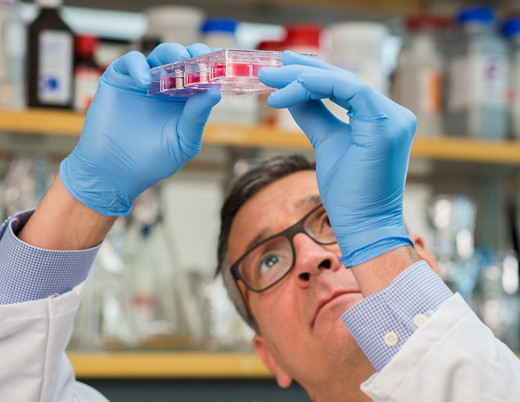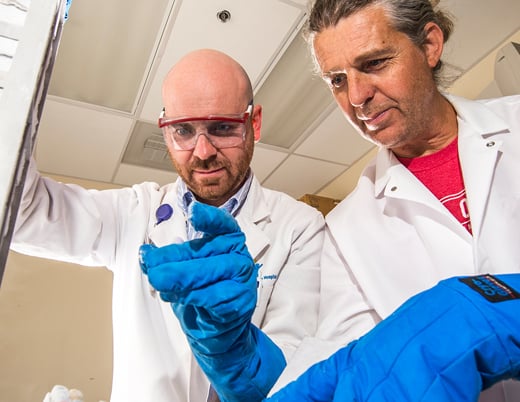Will a new drug work in combination with radiation therapy to target high-grade gliomas?
There are very few effective treatments for high-grade glioma. So when a novel drug called selinexor produced promising results in both pediatric and adult lab models, as well as adult clinical trials, researchers worked quickly to make it available for study in the pediatric realm.
In many types of cancer, the nuclear export protein exportin 1, or XPO1, is overexpressed — it exports out of the nucleus the tumor suppression proteins necessary to regulate cell growth. Selinexor functions by binding with and inhibiting XPO1, allowing tumor suppressor proteins to remain in place.
“That’s what’s so fascinating about it,” says Children’s Hospital Colorado pediatric oncologist Adam Green, MD. “When you think of a targeted chemotherapy medicine like this, it usually only works in a small subset of cancers. But because many cancers have issues with dysregulation of tumor suppressor proteins, it has the potential to make a wide impact.”
Studying how selinexor affects cancers
In 2012, Dr. Green was part of the first research team to study selinexor in high-grade glioma. Then a fellow at Boston Children’s Hospital, he worked in a lab at Dana-Farber Cancer Institute and studied the medicine in pediatric and adult high-grade glioma models.
In tandem with lab work, he helped bring a multicenter clinical trial online in 2013 for adult glioblastoma. Although he’s no longer directly involved in that clinical trial, Dr. Green says work is still ongoing, and it continues to produce promising results.
Multiple national and international clinical trials have now studied or are continuing to study the drug’s effectiveness in various adult cancers. In fact, a trial called Selinexor Treatment of Refractory Myeloma, or STORM, ultimately led the FDA to approve use of selinexor in July 2019 for adult patients with multiple myeloma.
Selinexor in pediatric clinical trials
In 2014, Children’s Oncology Group and the National Cancer Institute opened the first pediatric clinical trial to study selinexor in kids with recurrent and refractory solid and brain tumors based on Dr. Green’s work in the lab. Still ongoing at 22 sites across the country, including Children’s Colorado, the phase 1 trial aims to find the best dose as well as study the side effects.
They study about six kids at a time for one cycle, or four to six doses over a month. At the outset, they used a slightly lower dose than adult clinical trials, adjusting for the size of each child. For each subsequent cycle, they’ve treated patients at a higher or lower dose based on tolerance of the previous six patients.
He says they’re getting close to an ideal dose.
In parallel, researchers have been studying high-grade glioma models to determine how selinexor gets to the tumors and how it affects them.
The next phase
In recent research published last year, Dr. Green and his team found that selinexor inhibits the NF-κB pathway in high-grade glioma and strongly induces the expression of nerve growth factor receptor, or NGFR. The results helped them better understand selinexor’s mechanism of action and identify that NFGR is a biomarker of its effect. Dr. Green says the research also suggests that a combination therapy strategy could be a promising approach.
A phase 2 trial is on track to open later this year at 120 national and international sites under Dr. Green’s leadership. Enrollees will receive a combination of selinexor and radiation at the beginning of their treatment. Once they finish radiation, they’ll continue on selinexor alone.
Historically, radiation has been the only effective treatment for these kinds of tumors. It’s not curative, but it typically stops the tumor from growing for several months.
“We’ve done a lot of parallel work in the lab looking at treatment combinations including this one,” says Dr. Green. “Selinexor and radiation seem to work synergistically.”
A key outcome of the phase 2 trial will be what percentage of patients survive after one to two years of treatment on the study. They’ll compare how patients do on the study with those who’ve been treated with radiation alone or with other treatments. The hope is that the selinexor-radiation patients survive substantially longer with an adequate quality of life. That could mean researchers are headed in the right direction.
Additional lab work
They plan to obtain the tumors of patients they treat with the selinexor-radiation combination for further study in the lab.
“Having those human tumors will allow us to see if what our current tumor models have been telling us is right,” he says. “We should be able to find out a lot more about selinexor, including what patients are most likely to respond and what patients may not respond as well and should be given another type of treatment.”
Featured Researchers

Adam Green, MD
Pediatric neuro-oncologist
Center for Cancer and Blood Disorders
Children's Hospital Colorado
Associate professor
Pediatrics-Hematology/Oncology and Bone Marrow Transplantation
University of Colorado School of Medicine





 720-777-0123
720-777-0123










